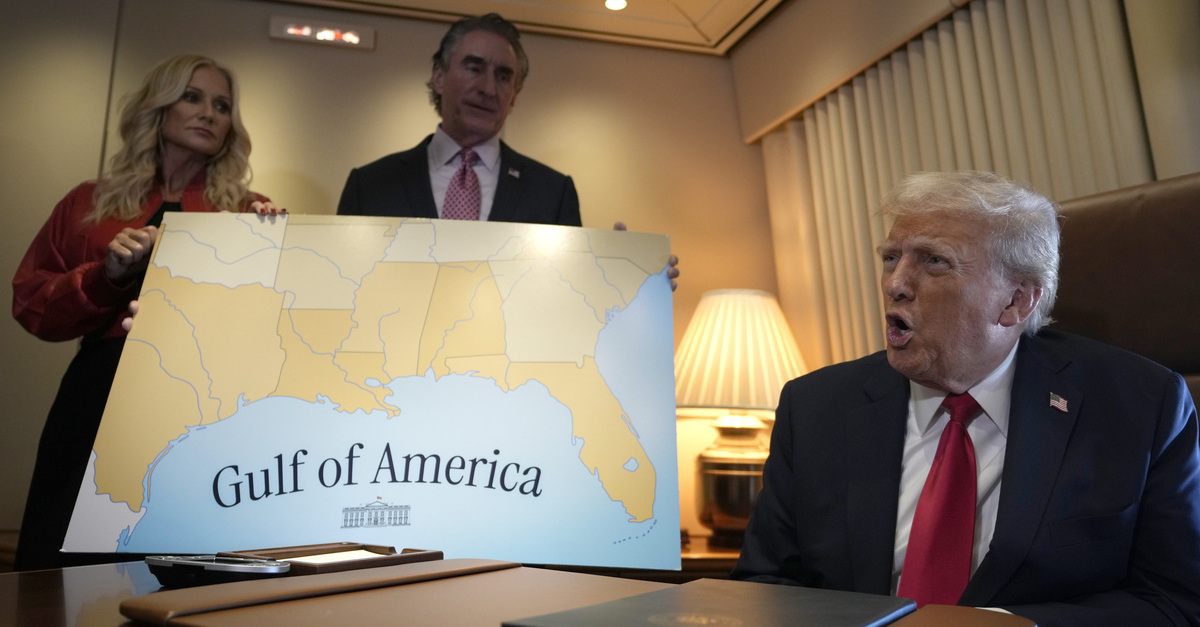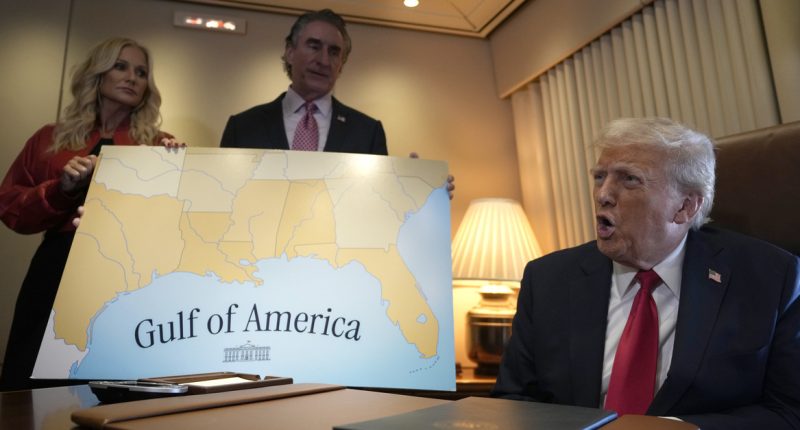
President Donald Trump, from right, speaks to reporters accompanied by Interior Secretary Doug Burgum and Burgum’s wife Kathryn Burgum, aboard Air Force One where Trump signed a proclamation declaring Feb. 9 Gulf of America Day, as he travels from West Palm Beach, Fla. to New Orleans, Sunday, Feb. 9, 2025 (AP Photo/Ben Curtis).
The Trump administration is attempting to block an order by a federal judge in Washington, D.C., forcing it to let The Associated Press back into the White House press pool this week after the president tried barring the news outlet over its refusal to refer to the Gulf of Mexico as the “Gulf of America.”
The Justice Department filed a motion Wednesday to stay U.S. District Judge Trevor McFadden’s preliminary injunction issued on Tuesday granting the AP’s request to block the White House’s ban on its access to the Oval Office, East Room and other sites of press events — saying the ban amounted to “impermissible viewpoint discrimination.” McFadden noted how the AP was likely to prove in court how it “suffered unlawful retaliation for exercising its speech rights,” despite claims by the Trump administration that it deserved the ban.
“Access restrictions must be reasonable and not viewpoint based,” McFadden wrote. “While the AP does not have a constitutional right to enter the Oval Office, it does have a right to not be excluded because of its viewpoint. And the AP says that is exactly what is happening.”
On Wednesday, the DOJ claimed that there have been no allegations that the Trump administration has restricted The Associated Press’s speech and is not “adopting content-based restrictions on what may be uttered in the Oval Office, controlling any reporter’s ability to send text messages or photos in areas of the White House to which they are admitted, or a prior restraint on the Associated Press’s publications,” according to its motion to stay McFadden’s order.
It argues that the AP case, instead, centers around “special access to the president’s personal and private spaces,” which the D.C. Circuit has “refused to consider under a forum analysis,” according to the DOJ motion.
“The Preliminary Injunction constitutes an unprecedented intrusion into Executive authority,” the filing says.
“A court issued an order to control access to the President’s most intimate spaces: his personal workspace (the Oval Office), his means of transportation (Air Force One), and his personal home (the Mar-a-Lago Club),” the DOJ claims. “It did so largely by conducting a forum analysis, which is used by courts to evaluate restrictions on speech, and by equating spaces for large press gatherings with more limited, personal spaces such as the Oval Office.”
Trump administration officials informed the AP and its text-based reporters on Feb. 11 that it would bar them from entering certain areas as members of the White House press pool “unless the AP began referring to the Gulf of Mexico as the Gulf of America, following President Trump’s renaming of that body of water in Executive Order 14172,” which was titled, “Restoring Names That Honor American Greatness.” Later, AP photographers were allegedly banned as well.
The White House later accused the outlet of refusing to “adhere to what the president believes is the law.”
On Feb. 21, the AP filed a lawsuit in federal court accusing the White House of engaging in “content- and viewpoint-based discrimination” in violation of the First Amendment. The complaint requested a temporary restraining order and asked the court to reverse the ban. An amended filing added the photographer ban to the complaint and pushed for a preliminary injunction.
Following a hearing in February, McFadden refused to grant the “extraordinary” relief of an injunction, but signaled that the administration would have a difficult time defending its decision when it came time to argue on the merits. “It seems pretty clearly viewpoint discrimination,” McFadden said at the time.
In his Tuesday order, the judge said the White House could restrict access to as many reporters as it wants. Where the government goes wrong, McFadden said, is picking and choosing which ones to keep based on press style.
“This injunction does not limit the various permissible reasons the Government may have for excluding journalists from limited-access events,” McFadden explained.
More from Law&Crime: ‘Under established law’: Supreme Court nixes district court order demanding reinstatement of fired federal workers
The press pool is a nearly 144-year-old institution whose members have, for decades, been under the purview of the 111-year-old White House Correspondents Association (WHCA), a nonprofit famously responsible for its annual dinner. The concept of the pool itself, however, was essentially invented by the AP, with its reporters and photographers being White House media staples for years.
The DOJ said Thursday that McFadden and the lower court should “exercise caution and at least stay its ruling” regarding The Associated Press’ access to the Oval Office, Air Force One and Mar-a-Lago until the outcome of Defendants’ appeal.
“Underlying the Court’s ruling are profound separation of powers issues,” the DOJ said. “The Executive maintains that the President has the right to dictate who is permitted in his personal spaces for any reason, no less than any American has the right to dictate who enters their personal office space, vehicle, or home. It would be unreasonable for the President to lose the right to control who is in his private spaces (including his private home, the Mar-a-Lago Club) simply because he becomes President. Moreover, until the questions presented in this case are resolved on appeal, the Court risks unending litigation every time a reporter from the Associated Press is rejected for entry into the press pool, Mar-a-Lago Club, Air Force One, or the Oval Office on grounds that the Associated Press may find improper (or falsely speculate are pretextual) but have nothing to do with the content of its speech. The Court should permit appellate review of this issue before imposing its order.”
While McFadden’s order was considered a win for the AP, the judge noted Tuesday how the Trump administration isn’t being blocked permanently from stripping AP’s access to the Oval Office, East Room, or any other White House media event.
“The Court simply holds that under the First Amendment, if the Government opens its doors to some journalists — be it to the Oval Office, the East Room, or elsewhere — it cannot then shut those doors to other journalists because of their viewpoints,” McFadden’s order reads. “The Constitution requires no less.”
The Trump-appointed judge explained the AP will no longer be entitled to the “first in line every time” permanent press pool access the media outlet “enjoyed under the WHCA.” The court’s order also does not prohibit the Trump administration from “freely choosing which journalists to sit down with for interviews or which ones’ questions they answer” during press events, the judge added.
“But (the AP) cannot be treated worse than its peer wire services either,” McFadden concluded. “The Court merely declares that the AP’s exclusion has been contrary to the First Amendment, and it enjoins the Government from continuing down that unlawful path.”
Love true crime? Sign up for our newsletter, The Law&Crime Docket, to get the latest real-life crime stories delivered right to your inbox.
Jerry Lambe contributed to this report.








